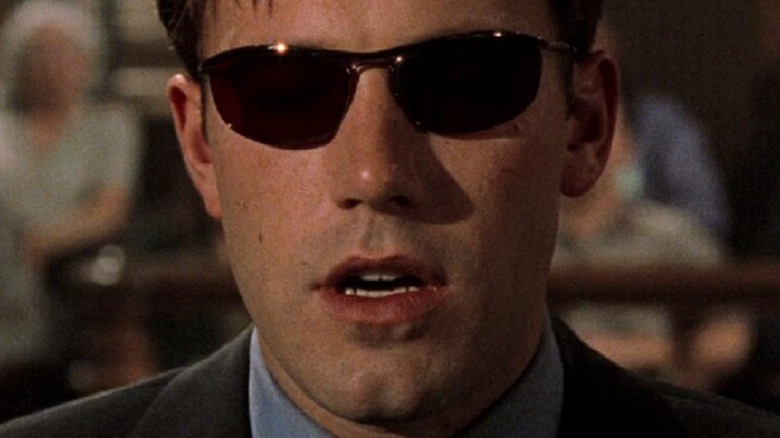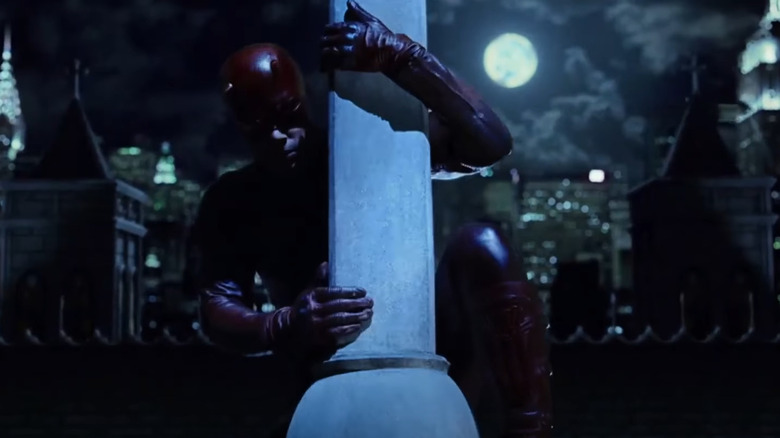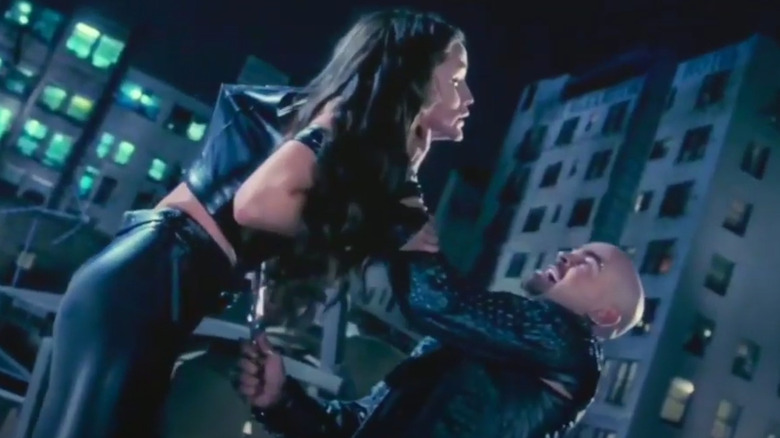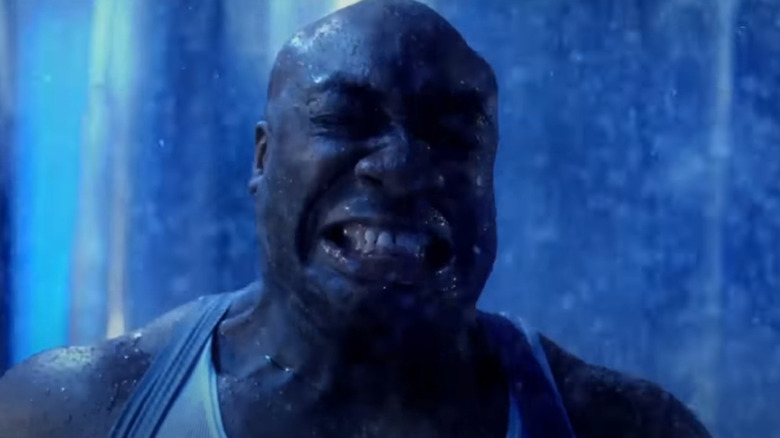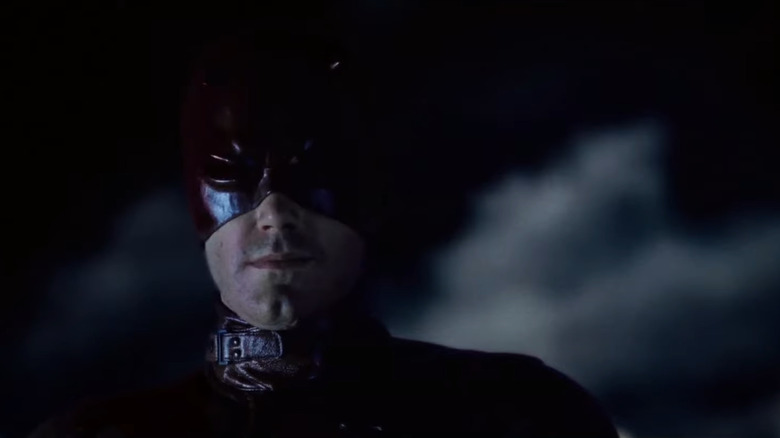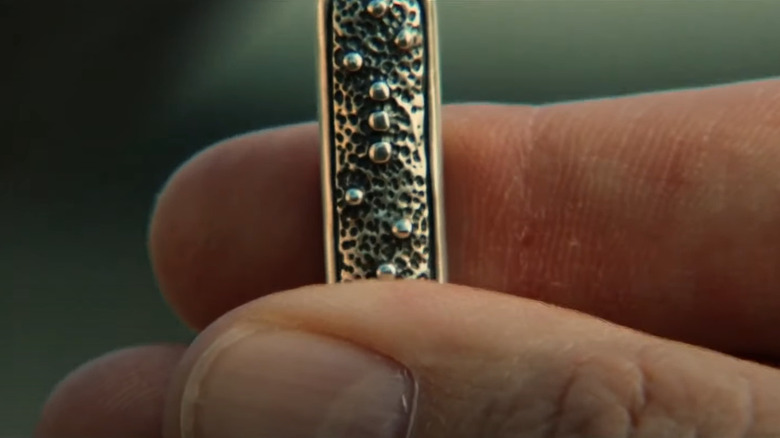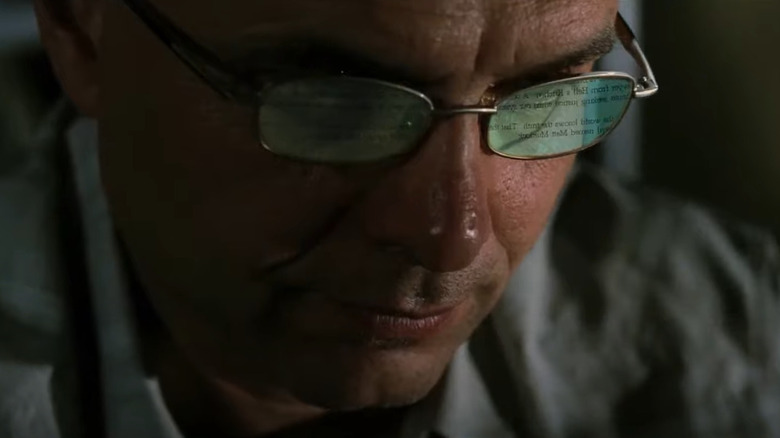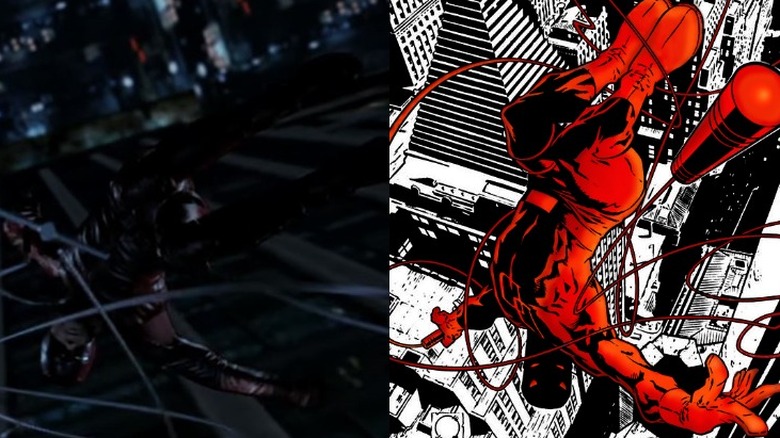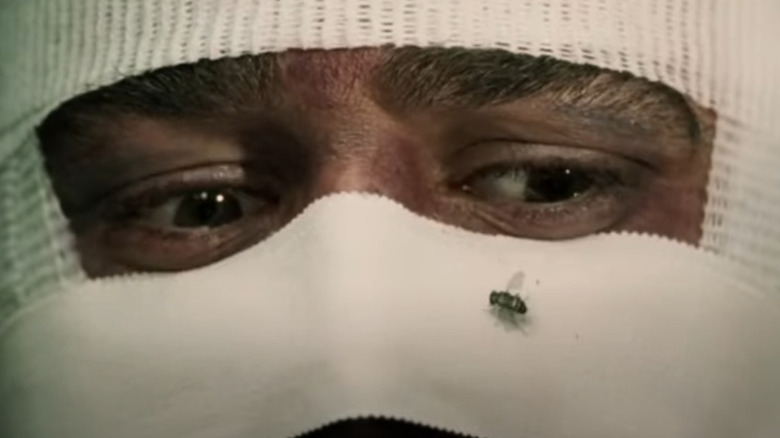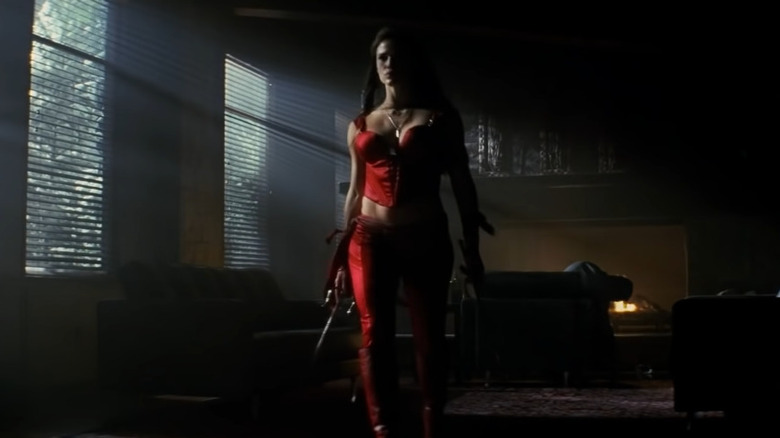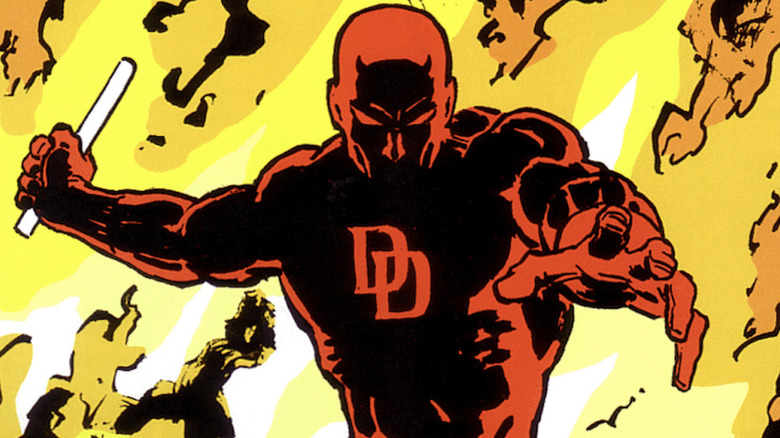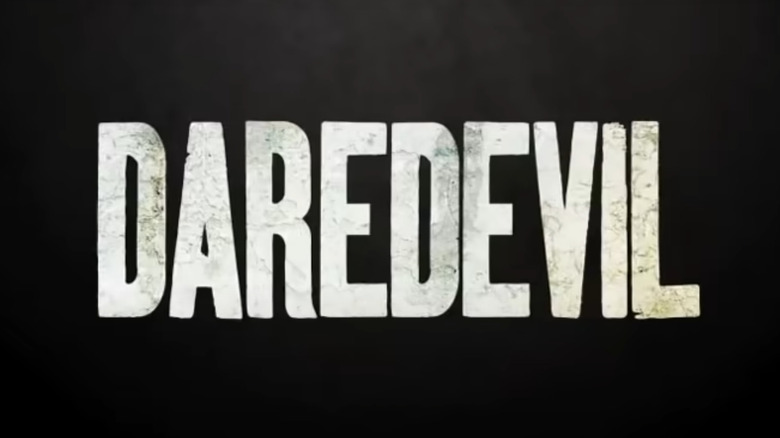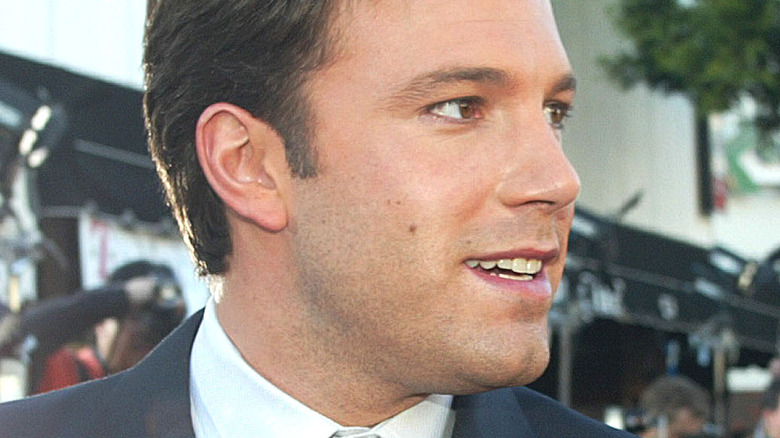The Ending Of Daredevil Explained
In today's age of billion-dollar comic book adaptations and superhero cinematic universes, it's hardly surprising that so few people have time for the 2013 film "Daredevil." Despite debuting at a time when audiences had much lower expectations for Marvel movies, this attempt at bringing Matt Murdock to life didn't quite hit the mark, failing to show the average moviegoer what makes this blind lawyer from Hell's Kitchen such a compelling protagonist. As AV Club's Keith Phipps put it, "[O]n the heels of such successful comic book adaptations as 'X-Men' and 'Spider-Man,' [writer-director Mark Steven Johnson's] film makes Daredevil look like the second-rate hero he never really was."
This was the movie that made its lead actor — known to be a comic book fan — turn his back on live-action superhero roles for more than a decade. It also doesn't help that a superior interpretation of the character exists in the form of the Netflix "Daredevil" series, a take on the Man Without Fear that was so well-received by fans that it was formally integrated into the Marvel Cinematic Universe after years of ambiguity.
The film pales in comparison to the Netflix show, but there are still some fans of this much-maligned movie, particularly of the Director's Cut. The ending teased a few things that, at the very least, would have been interesting to see in a pre-MCU period of superhero cinema. This is the ending of "Daredevil," explained — plot resolutions, Easter eggs, and more.
The introduction starts to make sense
After its brief, Braille-inspired intro sequence, "Daredevil" opens with the titular character (portrayed by Ben Affleck) in a precarious situation. Dressed in full superhero garb, the Man Without Fear seems gravely injured for unknown reasons, holding on to a cross on top of a church as his blood flows over a stained-glass image of the Virgin Mary. With great effort, the wounded Daredevil uses his grappling hook to lower himself to safety inside the church, but loses his grip a few feet before touchdown and lands with a painful thud in front of the altar. The resident priest, Father Everett (Derrick O'Connor), rushes to the costumed adventurer's aid, taking off Daredevil's cowl and expressing no surprise when he sees the man beneath it. As Father Everett tries to help Matt get back on his feet, the blind lawyer's life starts to flash before his eyes.
This was an interesting way to open the movie, as it leaves the viewer with more questions: How does the priest know who Daredevil really is? How did Daredevil get seriously injured in the first place? And where is his opponent? By the end of the film, we know the answers. Father Everett is Matt's frequent confidant, and Daredevil's wound came courtesy of his lover Elektra Natchios (Jennifer Garner), who died at the hands of criminal marksman Bullseye (Colin Farrell). But how did this all play out?
Elektra's end (and an editing error)
The battle between Elektra and Bullseye is brief but brutal, not ending well for the former. After the death of her father at Bullseye's hands, Elektra equips herself with a pair of sai (complete with a so-early-2000s-it-hurts training montage with Evanescence playing in the background) and goes after the man she mistakenly thinks is the killer: Daredevil. Who, of course, is secretly her beau Matt. As Daredevil hesitates to fight her, he is swiftly defeated by Elektra, who angrily stabs him through the shoulder (the injury that causes the hero to bleed in the opening sequence). She then unmasks him and quickly realizes her mistake — after which the real culprit appears behind them, itching for a fight.
An angry Elektra engages Bullseye in one-on-one combat. She throws her sai at Bullseye, which he effortlessly catches and throws right back at her, piercing her hand. In response, he whips out a playing card and, in a single swift motion, slashes her throat. Then, in a scene ripped straight from the pages of 1982's "Daredevil" Vol. 1 #181, the crazed marksman delivers the coup de grâce by joyfully running Elektra's own weapon through her abdomen.
Unfortunately, a blink-and-you'll-miss-it editing error nearly ruins this moment. When Bullseye kills Elektra, the sai goes through her body at a 145-degree angle, which is impossible given the shape of the weapon. Perhaps Bullseye possesses secret physics-defying powers we don't know about.
The fall of the Kingpin
In the film's climactic battle, Daredevil comes face to face with chief opponent Wilson Fisk (played in a stellar performance by the late Michael Clarke Duncan) in the latter's office. Despite being at a serious disadvantage due to the injuries he sustained while fighting Bullseye, the Man Without Fear still challenges the criminal mastermind to a duel at his own doorstep. The (literally and figuratively) huge villain even takes note of this as he unmasks the severely weakened Daredevil and beats him to a pulp, saying, "It's a shame you came here wounded. I would have loved to fight you in your prime."
To even the odds, Daredevil gets a last-minute idea: He activates the office's sprinkler system, allowing his enhanced senses to hone in on the Kingpin's location and anticipate his moves as the torrential water bounces off the crime lord's skin. Matt is then able to put up a proper fight and get the better of the Kingpin. By the end of the film, Fisk's crimes are publicly exposed, so he is finally sent to jail.
In a 2006 interview with Latino Review, Duncan expressed interest in reprising his role in a possible sequel — with the condition that he didn't need to regain all the weight he had to put on for the role. He even shared his own thoughts about where to take the Kingpin's story next, suggesting that the character should use his time in jail to get jacked for the rematch.
The duality of Daredevil
One of the many ongoing plot threads in the narrative of "Daredevil" is Matt's internal struggle to come to terms with his dual life. By day, he operates within the law, a blind lawyer who, with his partner, Foggy Nelson (Jon Favreau), takes on pro bono cases and defends the poor against wealthy oppressors. By night, he dispenses his own brand of justice as the masked vigilante Daredevil, embracing a life of violence to punish those he sees as beyond Lady Justice's clutches. This inherent contradiction in his everyday life leaves Matt a tortured and conflicted soul, as evidenced by the fact that he goes to Father Everett's confessional to admit his "sins."
By the end of "Daredevil," Matt appears to have gained a sense of clarity about his choices and destiny. In his confrontation with the Kingpin, the Man Without Fear powerfully declares to his defeated foe: "I'm not the bad guy." After this, he coolly walks away, leaving the arriving police officers to deal with the big-time criminal. In the film's final scene, Daredevil stands on a rooftop, acknowledges New York Post journalist Ben Urich (Joe Pantoliano) from afar, and runs off into the night, embracing his role in Hell's Kitchen as its self-appointed "guardian devil."
The braille necklace
Days after the Kingpin's incarceration, Matt Murdock takes a walk on the streets of New York. Still saddened by the death of his lover, he makes his way to the rooftop where he and Elektra shared their first kiss — and to his surprise, he finds a trinket hanging from a steel frame, seemingly waiting for him there. He instantly recognizes it as the necklace that Elektra used to wear after he runs his fingers on the pendant and feels the newly added braille inscription (which, strangely enough, spells out "Ailektra" instead of "Elektra," as fans have pointed out). Though it is not explicitly stated, the fact that someone had to put the newly Braille-embossed necklace there gives Matt a faint glimmer of hope that Elektra may still be out there, alive. (Of course, as comic fans undoubtedly know, Elektra's death at the hands of Bullseye was far from final.)
In 2005, 20th Century Fox provided a definitive answer to this dangling mystery with the release of the spinoff movie "Elektra," in which Jennifer Garner reprised the role of the titular assassin. The full-length feature even had a deleted scene with Ben Affleck's Matt Murdock appearing before Elektra in a dream, inviting her to "come back." Elektra declines, saying that she'll return to her beloved when she's ready. They share an embrace before Elektra wakes up in her room, all alone.
Daredevil's secret is safe
One of the running subplots in "Daredevil" was the journey of New York Post investigative writer Ben Urich, who follows the trail of violence and destruction left by both Daredevil and the Kingpin throughout the city. Using his keen journalistic instincts and some key pieces of evidence, he is able to piece together the answers to many mysteries surrounding the two men, including the true identity of the Man Without Fear. By the end of the film, Ben is typing up what could easily be the expose that makes his entire career: A lengthy feature on the two powerful players in Hell's Kitchen, ending with the revelation that Daredevil is in fact the blind lawyer Matt Murdock.
However, the veteran reporter has a last-minute change of heart, largely because of the incredible amount of good that Daredevil has done for the community. It is also likely that Ben realizes how much damage the revelation of Daredevil's secret identity could do to the personal life of the man who has single-handedly been trying to make their neighborhood a better place. He ends up deleting his article, and walks out of the Post to have a smoke. He spots Daredevil standing at the top of a building across the street, perhaps aware that Ben has pieced together his real identity. Ben whispers a statement of respect — "Go get 'em, Matt" — after Daredevil swings away.
Opening and ending shots straight from the comics
Say what you will about the overall quality of "Daredevil," but it's clear that the people who worked on the project were fans of the source material. Perhaps the clearest evidence of this is the way they bookended the feature with scenes featuring the protagonist in poses pulled straight from iconic comic book covers illustrated by superstar artist Joe Quesada.
As mentioned earlier, the opening shot of "Daredevil" features the Man Without Fear with his arm around a gigantic stone crucifix. While not a perfect recreation, it's an undeniable homage to the cover of 1998's "Daredevil" Vol. 2 #3, which features the scarlet-clad swashbuckler of Hell's Kitchen in a similar pose. Meanwhile, the final shot of the film — which features Daredevil fearlessly leaping off a tall building and throwing his grappling hook in the direction of the camera — is an unmistakable reference to "Daredevil" Vol. 2 #1.
It's interesting to note that both issues are part of a story arc penned by Kevin Smith titled "Guardian Devil," which is exactly what Matt calls himself at the end of the movie. A trade paperback compiling all the issues in the "Guardian Devil" arc was released a few years before "Daredevil" hit the silver screen, with an introduction written by none other than Ben Affleck.
The Bullseye stinger
At a time when post-credit scenes in superhero movies were more of a neat but largely inconsequential bonus as opposed to an obligatory inclusion, the after-credits stinger for "Daredevil" featured a brief but memorable sequence that was clearly intended to tease a possible sequel development.
In the aftermath of his bloody skirmish with Daredevil, Bullseye is seen in a heavily guarded facility, covered in bandages and lying in a hospital bed. With both of his hands wounded by a sniper's bullet during the church battle, audiences would reasonably expect that the eagle-eyed assassin's sharpshooting abilities would no longer pose a threat to anyone. As the camera zooms in, a fly zips into the frame, thoroughly irritating the bandaged Bullseye as it lands on his gauze-wrapped face. The injured marksman is then seen desperately reaching for whatever makeshift weapon his injured fingers could pilfer from the medical tray by his bedside. Seconds later, a loud thunk is heard, and the camera reveals that the hapless fly had been pinned to the wall with a medical syringe. Satisfied, the sharpshooter mutters "Bullseye" under his breath, hinting that his talents — and more importantly, his capacity to use them — were far from gone.
Honestly, we may never know for sure if Colin Farrell's character was indeed being set up for a sequel return. Still, the fact that the filmmakers included this scene is more than enough to suggest that at the very least, it may have been considered.
The Elektra spinoff
Two years after "Daredevil" opened to promising box office numbers but lukewarm reviews, 20th Century Fox released "Elektra," a spinoff of sorts that starred Daredevil's sai-slinging love interest. Resurrected through spiritual means, Elektra has turned her back on her old life. She resurfaces as an assassin hired by the mysterious global organization known as the Hand. However, the Hand becomes angry when Elektra's pesky conscience causes her to spare the lives of her assigned marks, a father and daughter with unexpected martial arts skills. They send a group of killers after her (including a character named Typhoid, based on Daredevil's enemy and former lover Typhoid Mary).
The film features elements of mysticism that make it tonally distinct from "Daredevil." However, just like "Daredevil," "Elektra" didn't exactly receive the warmest of welcomes. On Rotten Tomatoes, it has a paltry 11% score, making it second only to 2015's "Fantastic Four" as the worst-rated Marvel movie on the site (9%).
What the sequel could have been like
Discussions about a sequel to "Daredevil" started a few months after the film debuted in theaters. In an interview with UGO published in August 2003, director Mark Steven Johnson expressed interest in helming a sequel tailored after the "Born Again" storyline from the comics. He also considered making Mr. Fear a primary antagonist. "The idea of a guy who could release fear into your system would be cool," the filmmaker said. Meanwhile, Ellen Pompeo, who played the role of Matt Murdock's secretary Karen Page, suggested in an interview with the Los Angeles Times that her character's more mature storylines from the comics may be explored in future sequels.
In January 2004, producer Kevin Feige said that while the Man Without Fear had many classic tales that were well-suited for cinematic adaptations, the then-upcoming "Elektra" spinoff was Marvel's top priority. As time passed, however, the "Daredevil" sequel found itself stuck in Hollywood limbo, constantly falling behind schedule as the clock continued to tick for 20th Century Fox, which needed to make another film to retain the character license.
In a 2013 article, Deadline confirmed what many fans had been speculating about and anticipating. The rights to Daredevil had finally reverted to Disney, which had already acquired Marvel, meaning that the character and his world could at last be incorporated into the ever-growing tapestry of the Marvel Cinematic Universe.
The failed reboot attempt
Before Daredevil's cinematic rights went back to Marvel Studios, there were plans to initiate a franchise reboot under 20th Century Fox — plans that involved, at different points, a continuation of the 2003 film, a crossover film, and a brand-new trilogy.
In 2011 — eight years after "Daredevil" — Entertainment Weekly reported that the studio had tapped director David Slade to helm a movie that would "continue the story of the blind superhero [...] but feature a brand new cast." Slade said (per Collider) that his take would have been "complex and exciting," but he exited the project the same year, leaving it in development hell. At around the same time, another Marvel project was also being quietly developed by Fox, one that would feature all its licensed Marvel characters (including Daredevil) in a "Civil War" style crossover movie (via Flickering Myth). Sadly, this was also scrapped.
Months before Fox lost the Daredevil license, director Joe Carnahan pitched his take on the character and even prepared a sizzle reel. In a SyFy interview cited by Collider, Carnahan shared more details. "I suggested a trilogy as follows: 'Daredevil '73,' 'Daredevil '79,' and 'Daredevil '85,' where I was going to do a kind of 'cultural libretto' and make the music of those eras a kind of thematic arc," he said. "The problem was, the option was almost set to lapse so we made an eleventh hour bid to Marvel to retain the rights for a bit longer so I could rework the script. Unfortunately, it just didn't happen. Marvel wanted the rights back. I don't blame them."
How Daredevil made Ben Affleck hate superhero roles (for a time)
Perhaps the most tragic element of "Daredevil" was the impact it ultimately had on leading man Ben Affleck. Being someone who has openly admitted his love for the character, the critical failure of "Daredevil" understandably hit him hard. "[I] inoculated myself from ever playing another superhero," he said in a 2006 interview (via The Independent).
Despite his bold declaration, Affleck would wear the costumes of two massively popular superheroes years later. In 2006's "Hollywoodland," Affleck portrayed George Reeves, the 1950s actor who starred as Superman in a television show and a live-action film. Naturally, this involved Affleck donning the Man of Steel's suit. His vow to never portray another superhero would be properly broken when he played Batman in 2016's "Batman v Superman: Dawn of Justice" and its 2017 follow-up "Justice League." Affleck explained this decision in an interview with Playboy (via ComicBook.com). "If I thought the result would be another 'Daredevil,' I'd be out there picketing myself," he said.
Affleck has never been shy about taking shots at his "Daredevil" movie. The actor said during a TimeTalks Q&A (via NME) that the torrid time he had doing "Daredevil" influenced his decision when the chance to play Batman came along. "Part of it was I wanted for once to get one of these movies and do it right — to do a good version," he said. "I hate 'Daredevil' so much."
